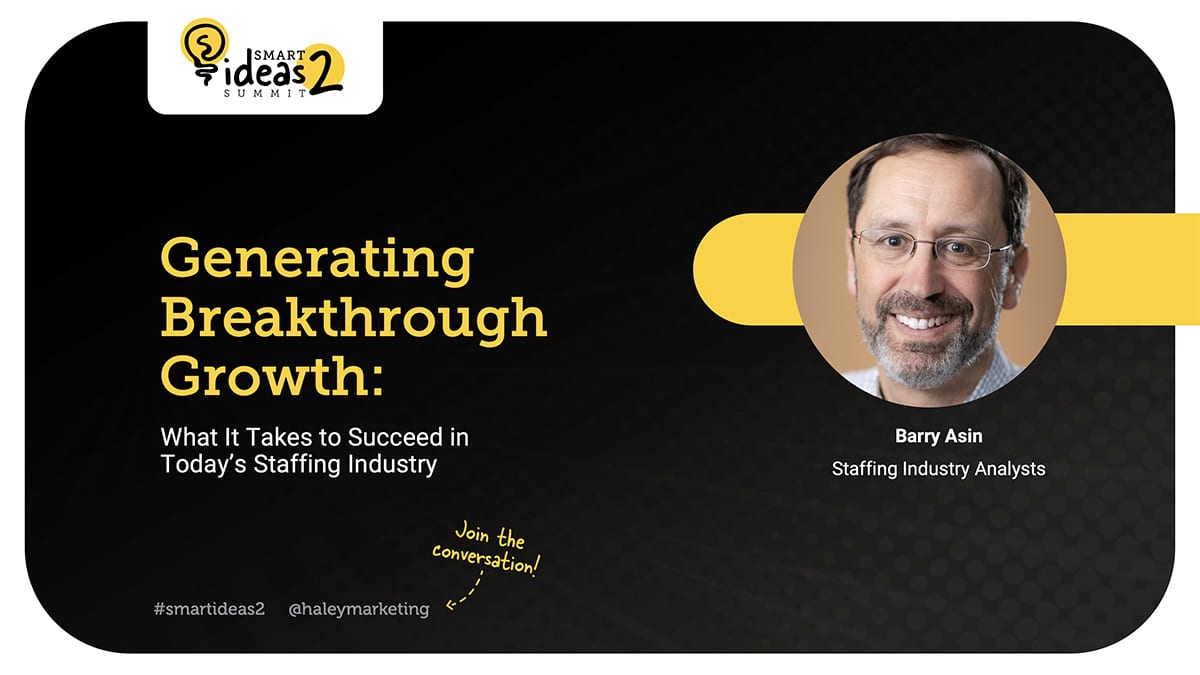Thank you to everyone who attended the SMART IDEAS Summit 2. The event was a huge success!
If you missed a session or want to rewatch or share any of the presentations, we have great news:
The SMART IDEAS Summit 2 Content Is Available on Demand!
Access the free recordings and slides for 14 educational presentations from some of the smartest minds in staffing here. All you have to do is enter your contact information to access the recordings. Then, you can start viewing simply by clicking on any session you like.
Session Recap: Generating Breakthrough Growth: What It Takes to Succeed in Today’s Staffing Industry
In this presentation, Barry Asin (President at Staffing Industry Analysts) breaks down how to not only survive, but experience breakthrough growth, in the modern staffing industry:
Video Transcript
Barry Asin:
First off, just thank you to David and to everybody at Haley Marketing for organizing this. I’m really, really delighted to be here. I’m excited to be talking about generating breakthrough growth. We’ll try to distill all of that into 20 minutes.
Hopefully, most of you know who Staffing Industry Analysts are, but we’re completely focused on research, events, editorial, certification, and training all around the staffing industry and the world of contingent work. We produce over 200 research reports a year. I’ll try to share with you right now of some of the highlights or at least the things that I think that are most interesting around this topic of breakthrough growth.
So I’m going to do this in two ways. The first is to talk about why I’m very optimistic about the industry and why I see this as a great place to be. And in fact, I think I’m more optimistic than I’ve ever been. And so just having made the choice to be part of the staffing industry, I think your organization is in for good opportunities ahead with the caveat that things are changing and the market’s getting more challenging in a lot of ways. But then I’m going to dive into what is it about staffing firms that perform better than the rest of the industry? So let’s focus first on what is it that we think is driving growth for the staffing industry in the near term and over the longer term.
What’s driving growth in the staffing industry right now?
Three key things that we’re very interested in. One is this idea of the talent shortage, which we know has always been there. I think now it’s a full-blown talent crisis; the new openness to flexible work, a lot of that driven by the pandemic, and the digital transformation that’s going on in the industry. And I’ll talk more about what I mean by that. So let’s talk first about this talent shortage to talent crisis.
Talent Crisis
If I had to put up one slide to just say, encapsulate what’s going on in the market right now, it’s this one. And the blue line is the number of open jobs in the United States. The red line is the number of people that are out there looking to find a job. And historically we’ve always had a situation, at least back to 2000, where there are more people looking for work than there were open jobs. In around 2016, 2017, that changed a little bit. And the pandemic has just lit that on fire. There are 6.7 million more job openings out there in the market right now than there are people looking for work.
And so that’s why despite all the talk of inflation and maybe possible recession and the like, there’s a long way to go before we cross that point where employers don’t have jobs open that they’re looking to fill. It’s narrowed a little bit over the past little bit, but I think that’s maybe the clearest sign that we have that recruiting is a huge challenge.
Certainly staffing firms point that out when we survey them. We do an every-other-month pulse survey, which by the way is free to participate. If you go to our website or shoot me an email, I can get you connected with the folks to get part of the pulse survey. There’s a whole lot of data that people get out of that. One little snippet of it is this, we’ve been asking back to 2013, how hard is recruiting? How hard is sales? And back in the middle of 2021, we were at record levels in terms of recruiting being far and away the challenge.
That has narrowed a little bit. You can see over the last number of months, sales has gotten harder, but still overall, when we talked to staffing firms, the big challenge that they’re having, the constraint on growth, is getting the talent. And trust me when I say that that is a way better situation to be in than a situation where you’ve got lots of workers out there and not enough job orders. That’s why right now we see that talent really is increasingly in the driver’s seat. And what that means is that staffing firms that can get that talent are in a great position. And this is a good situation to be in for the staffing industry. It means that the service that you all provide is highly valued by your clients. So that’s one of the big drivers of growth into the future.
Openness to Flexible Work
The other, as I mentioned earlier, is this new openness to flexible work. I think we can’t state this enough, that the pandemic has just been a big mind opener for the population at large, business leaders overall, about where work can get done, what sort of flexibility they’re willing to cope with and to offer to their employees. And it’s driven by that talent shortage and the pandemic, which showed that work can get done remotely in a very productive way. So in a lot of ways, I think this is a big opportunity for staffing firms.
Normally and historically, you’re recruiting in your local market. For many employers now they are more open than ever to this idea that you could recruit somebody across the state, across the country, maybe even around the world. As a way to illustrate that, a little bit of data here, just in IT developers, work obviously that can get done pretty much anywhere, the majority of demand for IT temp staffing is in North America, but the majority of software developers are everywhere else, Asia Pacific in particular.
So there is no talent shortage in a lot of ways. The workers are just not where they need to be. And I encourage all of you to think more flexibly about remote work and be that talent consultant to your clients and how you can help them broaden their take on the labor market. Now, all of this means some significant change for staffing firms. I think it’s a really positive thing for the growth of the industry and the opportunities that are out there. It does mean less focus on the local labor market. And I think what we’ll see is for staffing firm becoming more focused on being really great at finding particular skills, wherever those particular skills are.
The other interesting change here and where everybody is out there looking at their real estate costs, what is the right branch network? I don’t know that it’s necessarily the end of branch offices, but certainly it’s an opportunity for staffing firms. And we’ve seen every sort of configuration of back in the office, completely remote, hybrid, everything in between. And I think a real rethinking of what are these offices for and what role do they play in the business?
Digital Transformation
The final big driver for the growth of the industry into the future is digital transformation. You’ve heard a little bit here about the impact of technology in the industry. It does seem that more and more to be successful in this business, you’ve got to be great at mastering the technology that’s out there. Big opportunities for staffing firms in improving productivity and driving down costs overall and helping to get that talent and improving the speed. But it also is some change in disruption to the way that business has been conducted.
And I think the bar is going to continue to go up. And so that’s part of what I say about breakthrough growth is the bar is being raised. And so you’re not going to be able to be successful just doing the same old thing into the future. One of the ways that technology is changing things is with the growth of recruiter list platform models. This idea that through a staffing platform with an employee, as working as a staffing firm, working as an employer of records still W2 employee, but having recruiter list connection between hiring managers and workers, we’ve seen huge growth in that just in the past year. 190% growth in volume of that. Far faster growth than the industry has been growing and then in other areas of using technology to connect workers and work.
It does change the way that staffing firms need to operate. And it offers lots of opportunities, but we think over time, there’s going to be convergence between these tech-based solutions and traditional staffing firms with staffing firms looking a lot more like technology companies and tech companies adding more of the features of staffing businesses. We actually have a whole conference focused around that. That’s going to take place September 20th through 22nd in Dallas. And one of the big things I’m working on getting prepared for right now, but all about how technology is changing, the way that the industry functions.
Finally, as far as near-term outlook, just wanted to say that we’re pretty positive about the industry right now. This is more data from our pulse survey. You’ll get the slide to this after the event I’m told, but the last pulse survey that we did, a survey of 150 or more staffing firms, temp staffing was up running over 20% year over year in terms of revenue growth, direct hire executive search, even better than that. And then you can see, we actually break that down by the different segments of the industry. The median is probably the most useful to look at. The healthcare staffing industry is the place that has just been on fire, particularly the travel nurse business, as part of the coping with the pandemic really, and that doesn’t seem to be going away. The median travel nurse firm revenue through the end of June is still up 75% over 2021, which was up well over 100% over 2020 levels.
So that’s sort of a granular look on some survey data that we do. We also have some data on the outlook for the industry that we do with our friends from Bullhorn. This is the SIA Bullhorn staffing indicator. It does show that business is slowing. This is data we put out every week based on a sampling of Bullhorn clients made to represent roughly what’s going on in the industry. We do see some faster growth on the professional staffing side of things. And growth has definitely slowed down from 2021. But I do think that folks who are talking about recession, at least for the staffing industry right now, that seems a bit premature to me. So that’s a rapid-fire, just quick, big-picture outlook on the growth that’s available in the industry.
What does it take to outperform competitors and really break through?
The short answer on that is that it’s the quality of your leadership team and your business that we think is the thing that really is going to differentiate one staffing business from the other. And another way to think about that is what’s different about staffing firms that have grown and broken through the barriers to growth? Why is it that of the more than 19,000 staffing firms out there, there’s only 140 or so in our latest ranking, we came up with about 220 I think, staffing firms that are more than $100,000,000 in revenue? What’s different about those firms that are able to grow to achieve that level of success?
I’ve become rather obsessed with this whole topic over the last number of years. So obsessed actually that my colleague Mike Cleland, and I wrote a book about it called Breaking Through, which we studied a dozen or so staffing firms that went from startup to $100,000,000 in revenue and beyond, and tried to find what’s different about them. In short, I’ll give you the short encapsulation of that, is that every staffing firm runs into barriers to growth as they grow over time. In fact, the vast majority of staffing firms never make it out of that owner-operator dependent category. Really they’re limited in their growth. They’ll go up and down over time, but it’s by the capabilities and the time and the bandwidth of the CEO or the owner-operator. They reach that capacity level.
Those firms that have grown beyond that are able to have an independent operation that can operate when the owner isn’t there. And then to scale the business organically over time to replicate it in multiple markets and to add even new business lines. So there’s very predictable barriers. What we found is that the organizations that break through have a more disciplined leadership team and from more strategic to more tactical disciplines, we see five key disciplines of those leadership teams which I’ll run through briefly here. Those are commitment, direction, culture, talent development, and execution. So let’s take each of those one at a time.
Commitment
Most important I think, is this idea of commitment. And what I really mean is commitment to growth. The reason that staffing firms grow to 100,000,000 and beyond is because the leadership of those organizations is committed to growing. The fact is the majority of staffing firms that don’t grow, they might not actually want to grow. They might actually say that explicitly. It could be that it’s a lifestyle business, and there’s nothing wrong with that. The challenge with the lifestyle business is that the bar goes up every year to just stay the same. So what is the leadership team of your business trying to achieve? What is driving them and are they willing to sacrifice and take on risks, financial, professional, personal risks, to grow? Firms that are willing to do that are really the ones … That’s sort of the entry stakes for those firms that are able to grow over time. So wanting to grow, having the passion to do it, willing to sacrifice is key.
Direction
The next discipline is around direction, by which we really mean strategy. We have lots of resources to help with that. And I think the main strategic choices for staffing firms are what market segment, what skills are you going to serve? And what sort of model are you going to use to go after that competitive strategy? The really important thing here is that you’ve got alignment between your strategic goal and the operational capacities that you build, and that you’re able to adapt that over time. And then it’s aligned, it’s scalable and you’ve got the resources to actually execute on that strategy.
A classic example is a decision to be made: are you going to be a niche player or are you going to play in large volume VMs, MSP-driven contract accounts? There are different organizational and operational decisions that would naturally flow out of that strategy. Trying to do all of it, trying to be all things to all people, is a tough strategic place to be in. And in fact, good strategy is typically as much about what you say no to, as it is about what you actually do.
Culture
All right, the other key discipline, and I think these next two are really my favorites and the things that are maybe most distinctive in my mind about the firms that have really outperformed, culture is key. And we noticed that in all the fast-growing staffing firms that we’ve looked at, and I think it’s important to talk about what is culture? First off, every organization has a culture. There are good cultures, and there are bad cultures. You know, you can tell a culture. Oftentimes when you just start meeting the people in the organization, it’s the unwritten rules of what happens when the boss is away is one way to think about it.
The key thing among companies that really outperform is they have a high-performance culture, and that involves alignment among the team about what the purpose of the business is, what the story is, what the goal is and accountability among all of the players in the organization to really achieving those goals. And for organizations to scale, culture needs to be driven from the top, but it needs to then be delegated down and replicated throughout the organization.
The final thing I’ll say about that is just that actions speak louder than words: who you hire, who you fire and who you promote, tells your organization a lot about what you value. And if you’re hiring and promoting people who are toxic to your culture, that is a clear red flag for problems in achieving breakthrough growth. We’re very proud to honor high-culture staffing firms. I’d encourage organizations to participate in our Best Staffing Firms to Work for Competition. There’s no charge to do it. You get some great detailed report, even if you don’t win on how your culture is looking right now. But we find a high correlation between firms that are honored for Best Staffing Firms to Work For and those who join our Fastest Growing Staffing Firms list.
Talent Development
All right, so we talked about commitment to growth, direction and strategy, high performing culture, the next, and maybe the most unique category, is talent development. And I think this is something, my favorite example of this comes from organizations like the Allegis Group, which is the largest staffing firm in the United States, Insight Global which was folks who started their own business but were Allegis alumni. And if you talk to the people at the top of these organizations, what they’ll say is that they’re not really in the staffing business, they’re in the talent and leadership development business.
And what we’ve found among staffing firms that are able to grow is, they’re able to grow that next generation of leaders. Because in order to grow, you’ve got to be able to scale. And that means hiring the right people, evaluating them and deciding quickly if they fit or don’t fit once they’re on board, then training and developing those people and making sure that you’re motivating them on an ongoing basis.
On the hiring, one of the companies that we profiled in the book, a perpetual fastest growing staffing firm, Alku, Mark Eldridge, I think did a nice job here of summing up what his philosophy was, was that the right time to hire is whenever you’ve found the right person. And that investment mentality is key to growth.
Execution
Finally, after commitment, direction, culture, and talent development, it’s all about execution. I think that many staffing firms look at execution. These are things like your best practices, your tactics, your comp plans, your motivational things, all those things that are important to the business. But if you don’t have that foundation of these other things, the execution is not going to be enough.
The key for execution is that you have the competitive practices, you’re selling and you’re recruiting, is really the key here, that are aligned with your prior disciplines, that fit your culture, that fit your strategy, that are scalable and consistent, and that you take those best practices and you’re able to replicate them throughout the organization.
So that’s a pretty rapid-fire look at both why we’re very optimistic about these drivers for future growth in the industry and what I think it’s going to take to go beyond the general growth that you might have out there in the staffing industry, and to really break through those barriers to growth. At all of our events, we talk a lot about what it takes to excel. We have our healthcare staffing summit coming up this fall, and we’re excited to be finally getting back to Miami for Executive Forum next spring. And David, I think I’m going to have a few moments there to, I can stop sharing my screen and we can take some questions.
David Searns:
Awesome. Thanks, Barry. That was great. Yeah, we did have a few questions and the first is one I had asked you and all of our presenters in advance, but we’ll let you answer it in front of everybody. Are we in a recession?
Barry Asin:
Yeah, I think that by the classic definition of a recession of two quarters of negative economic growth, then maybe we are, but it’s the weirdest recession I’ve ever seen because typically to be called a recession, you need to have employment declining and unemployment rising. And we’re definitely are not, that is not what’s going on right now. So I would say, no, we are not. And it’s certainly, as far as staffing firms are concerned.
David Searns:
All right. So everybody remember that answer, because it might be coming up in a trivia question later. Just a hint for this afternoon. There was a question that came in as you were talking about the slide about overcoming growth and is the data only about temporary staffing or did it also cover retained search firms?
Barry Asin:
Well, I mean the firms that we study, I think all of the principles about breakthrough growth apply to, I mean, in a lot of ways they apply to any sort of business, but I’d say they applied to both. The firms that we studied were primarily temp staffing rooms, but many of them had retained search or certainly perm divisions as part of it. And I think when you think about all those things of culture, strategy, talent development, execution, those I think are fairly universal in the industry.
David Searns:
Would agree. Well, another question, how large of a company does someone have to be to compete for the best of staffing with SIA?
Barry Asin:
Yeah. The best staffing firms to work for? I think it’s by number of employees. I think the smallest might be down to 10 or 20 employees, somewhere in that range, and we do have different levels. So the awards are given both for large firms and for smaller firms as well.
David Searns:
All right. And a final question, which wasn’t in the question list but I had it, is you talked about the growth of staffing platforms and we’re certainly seeing that amongst our clients, adding apps to try to do that and amongst bigger clients coming in with just as a platform, but how do you see the small to midsize staffing company effectively competing when somebody comes in with the bankroll to be the Uber of staffing?
Barry Asin:
Yeah, well, we’ve asked that question. That was our gig economy conference that we talk a lot about the disruption and the like. I think there’s, first off, lots of tech tools. We have a whole category of what we call staffing platforms as a service. There are vendors out there who have tech tools that are targeted at small and mid-size staffing firms. We’ve written research about all of that. And so it can become part of your tech stack. And that’s why we talk about this idea of convergence, that staffing firms are going to start to look more like these platforms. Unlike the taxi industry, I don’t believe that the staffing industry overall is going to get caught flatfooted and get disrupted by some big Uber in the sky, but there is going to be a lot more pressure, I think, to be fast and agile with the way you connect with your candidates and your workers.
Barry Asin:
The classic example we saw on that was in healthcare at the height of the pandemic. The staffing firms that had good platform models that could enable them to fill jobs really quickly outgrew the rest of the industry by two or three X.
David Searns:
Yeah. I saw some of those stories at the Executive Forum. It was mind-blowing. So I’ll put another plug in for those who don’t go to the executive forum. And even if you’re not a bigwig staffing company, you learn so much about where the industry’s headed. It’s a fantastic conference and nothing wrong with being in Miami in February, actually the first week of March.
Barry Asin:
We like that as well. So thank you, David. Really appreciate you inviting me to be here.
Want more great content from the smartest minds in staffing?
Access the free recordings and slides for 14 educational presentations from the SMART IDEAS Summit 2.













